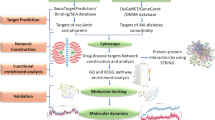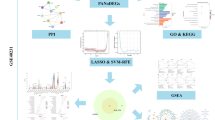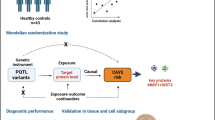Abstract
Objective
To investigate the mechanisms of Panax notoginseng saponins (PNS) in treating coronary heart disease (CHD) by integrating gene interaction network and functional enrichment analysis.
Methods
Text mining was used to get CHD and PNS associated genes. Gene–gene interaction networks of CHD and PNS were built by the GeneMANIA Cytoscape plugin. Advanced Network Merge Cytoscape plugin was used to analyze the two networks. Their functions were analyzed by gene functional enrichment analysis via DAVID Bioinformatics. Joint subnetwork of CHD network and PNS network was identifified by network analysis.
Results
The 11 genes of the joint subnetwork were the direct targets of PNS in CHD network and enriched in cytokine-cytokine receptor interaction pathway. PNS could affect other 85 genes by the gene–gene interaction of joint subnetwork and these genes were enriched in other 7 pathways. The direct mechanisms of PNS in treating CHD by targeting cytokines to relieve the inflflammation and the indirect mechanisms of PNS in treating CHD by affecting other 7 pathways through the interaction of joint subnetwork of PNS and CHD network. The genes in the 7 pathways could be potential targets for the immunologic adjuvant, anticoagulant, hypolipidemic, anti-platelet and anti-hypertrophic activities of PNS.
Conclusions
The key mechanisms of PNS in treating CHD could be anticoagulant and hypolipidemic which are indicated by analyzing biological functions of hubs in the merged network.
Similar content being viewed by others
References
Lau AJ, Toh DF, Chua TK, Pang YK, Woo SO, Koh HL. Antiplatelet and anticoagulant effects of Panax notoginseng: comparison of raw and steamed Panax notoginseng with Panax ginseng and Panax quinquefolium. J Ethnopharmacol 2009;125:380–386.
Ng TB. Pharmacological activity of sanchi ginseng (Panax notoginseng). J Pharm Pharmacol 2006;58:1007–1019.
Chen S, Liu J, Liu X, Fu Y, Zhang M, Lin Q, et al. Panax notoginseng saponins inhibit ischemia-induced apoptosis by activating PI3K/Akt pathway in cardiomyocytes. J Ethnopharmacol 2011;137:263–270.
Hong SJ, Wan JB, Zhang Y, Hu G, Lin HC, Seto SW, et al. Angiogenic effect of saponin extract from Panax notoginseng on HUVECs in vitro and zebrafish in vivo. Phytother Res 2009;23:677–686.
Zhang YG, Zhang HG, Zhang GY, Fan JS, Li XH, Liu YH, et al. Panax notoginseng saponins attenuate atherosclerosis in rats by regulating the blood lipid profile and an anti-inflammatory action. Clin Exp Pharmacol Physiol 2008;35:1238–1244.
Barabási AL, Oltvai ZN. Network biology: understanding the cell’s functional organization. Nat Rev Genet 2004;5:101–113.
Wu X, Jiang R, Zhang MQ, Li S. Network-based global inference of human disease genes. Mol Syst Biol 2008;4:189.
Guan J, Lai CM, Li SP. A rapid method for the simultaneous determination of 11 saponins in Panax notoginseng using ultra performance liquid chromatography. J Pharm Biomed Anal 2007;44:996–1000.
Montojo J, Zuberi K, Rodriguez H, Kazi F, Wright G, Donaldson SL, et al. GeneMANIA cytoscape plugin: fast gene function predictions on the desktop. Bioinformatics 2010;26:2927–2928.
Smoot ME, Ono K, Ruscheinski J, Wang PL, Ideker T. Cytoscape 2.8: new features for data integration and network visualization. Bioinformatics 2011;27:431–432.
Huang da W, Sherman BT, Lempicki RA. Systematic and integrative analysis of large gene lists using DAVID bioinformatics resources. Nat Protoc 2009;4:44–57.
Kanehisa M, Goto S, Furumichi M, Tanabe M, Hirakawa M. KEGG for representation and analysis of molecular networks involving diseases and drugs. Nucleic Acids Res 2010;38:D355–D360.
Zhong ZG, Lv L, Chai LM, Wu DP, Zhang WY, Huang JL, et al. Effect of Panax notoginseng saponins on APP gene transcription in the brain tissue of SAMP8. J Chin Med Mater (Chin) 2011;34:77–80.
Li XD, Chang B, Chen B, Liu ZY, Liu DX, Wang JS, et al. Panax notoginseng saponins potentiate osteogenesis of bone marrow stromal cells by modulating gap junction intercellular communication activities. Cell Physiol Biochem 2010;26:1081–1092.
Li XD, Wang JS, Chang B, Chen B, Guo C, Hou GQ, et al. Panax notoginseng saponins promotes proliferation and osteogenic differentiation of rat bone marrow stromal cells. J Ethnopharmacol 2011;134:268–274.
Geng J, Peng W, Huang Y, Fan H, Li S. Ginsenoside-Rg1 from Panax notoginseng prevents hepatic fibrosis induced by thioacetamide in rats. Eur J Pharmacol 2010;634:162–169.
Liu WJ, Tang HT, Jia YT, Ma B, Fu JF, Wang Y, et al. Notoginsenoside R1 attenuates renal ischemia-reperfusion injury in rats. Shock 2010;34:314–320.
Wan JB, Lee SM, Wang JD, Wang N, He CW, Wang YT, et al. Panax notoginseng reduces atherosclerotic lesions in ApoE-deficient mice and inhibits TNF-alpha-induced endothelial adhesion molecule expression and monocyte adhesion. J Agric Food Chem 2009;57:6692–6697.
Lv L, Zhong Z, Wu D, Chai L, Zhang W. Effect of Panax notoginseng saponins on syp and tau gene expression in brain of senescence accelerated mouse. China J Chin Mater Med (Chin) 2009;34:1261–1263.
Wang J, Wu L, Zhang W, Deng C. Effect of Panax notoginseng saponins on vascular intima hyperplasia and PCNA expression in rat aorta after balloon angioplasty. China J Chin Mater Med (Chin) 2009;34:735–739.
Qin JH, Zhu LQ, Cui W. Effects of Panax notoginseng saponins on expression of intercellular adhesion molecule-1 in human umbilical vein endothelial cells injury induced by oxidized low-density lipoprotein. Chin J Integr Tradit West Med (Chin) 2008;28:1096–1099.
Xie XS, Yang M, Liu HC, Zuo C, Li HJ, Fan JM. Ginsenoside Rg1, a major active component isolated from Panax notoginseng, restrains tubular epithelial to myofibroblast transition in vitro. J Ethnopharmacol 2009;122:35–41.
Wang W, Wang H, Rayburn ER, Zhao Y, Hill DL, Zhang R. 20(S)-25-methoxyl-dammarane-3beta, 12beta, 20-triol, a novel natural product for prostate cancer therapy: activity in vitro and in vivo and mechanisms of action. Br J Cancer 2008;98:792–802.
Tang YH, Zhang SP, Liang Y, Deng CQ. Effects of Panax notoginseng saponins on mRNA expressions of interleukin-1 beta, its correlative factors and cysteinyl-aspartate specific protease after cerebral ischemia-reperfusion in rats. J Chin Integr Med (Chin) 2007;5:328–332.
Gao RL, Chen XH, Lin XJ, Qian XD, Xu WH, Chong BH. Effects of notoginosides on proliferation and upregulation of GR nuclear transcription factor in hematopoietic cells. Acta Pharmacol Sin 2007;28:703–711.
Yang Z, Chen A, Sun H, Ye Y, Fang W. Ginsenoside Rd elicits Th1 and Th2 immune responses to ovalbumin in mice. Vaccine 2007;25:161–169.
Zhang HS, Wang SQ. Notoginsenoside R1 from Panax notoginseng inhibits TNF-alpha-induced PAI-1 production in human aortic smooth muscle cells. Vascul Pharmacol 2006;44:224–230.
Zhang LH, Jia YH, Sun XG, Xing FY, Liu ZF, Song G, et al. Effect of total Panax notoginseng saponins on the activity of human endothelial nitric oxide synthase gene promoter. J First Mil Med Univ (Chin) 2004;24:1113–1116.
Zhang W, Wojta J, Binder BR. Effect of notoginsenoside R1 on the synthesis of tissue-type plasminogen activator and plasminogen activator inhibitor-1 in cultured human umbilical vein endothelial cells. Arterioscler Thromb 1994;14:1040–1046.
Wang N, Wan JB, Chan SW, Deng YH, Yu N, Zhang QW, et al. Comparative study on saponin fractions from Panax notoginseng inhibiting inflammation-induced endothelial adhesion molecule expression and monocyte adhesion. Chin Med 2011;6:37.
Yuan Z, Liao Y, Tian G, Li H, Jia Y, Zhang H, et al. Panax notoginseng saponins inhibit Zymosan A induced atherosclerosis by suppressing integrin expression, FAK activation and NF-B translocation. J Ethnopharmacol 2011;138:150–155.
Si YC, Zhang JP, Xie CE, Zhang LJ, Jiang XN. Effects of Panax notoginseng saponins on proliferation and differentiation of rat hippocampal neural stem cells. Am J Chin Med 2011;39:999–1013.
Xu L, Liu JT, Liu N, Lu PP, Pang XM. Effects of Panax notoginseng saponins on proliferation and apoptosis of vascular smooth muscle cells. J Ethnopharmacol 2011;137:226–230.
Li XD, Liu ZY, Chang B, Liu DX, Chen B, Guo C, et al. Panax notoginseng saponins promote osteogenic differentiation of bone marrow stromal cells through the ERK and P38 MAPK signaling pathways. Cell Physiol Biochem 2011;28:367–376.
Li J, Xie ZZ, Tang YB, Zhou JG, Guan YY. Ginsenoside-Rd, a purified component from Panax notoginseng saponins, prevents atherosclerosis in apoE knockout mice. Eur J Pharmacol 2011;652:104–110.
Qiang H, Zhang C, Shi ZB, Yang HQ, Wang KZ. Protective effects and mechanism of Panax Notoginseng saponins on oxidative stress-induced damage and apoptosis of rabbit bone marrow stromal cells. Chin J Integr Med 2010;16:525–530.
Huang X, Tan H, Chen B, Deng C. Influence of astragalosides and Panax notoginseng saponins compatibility on MMP-9 and TIMP-1 after cerebral ischemia-reperfusion in mice. China J Chin Mater Med (Chin) 2010;35:2187–2191.
Luo FC, Wang SD, Qi L, Song JY, Lv T, Bai J. Protective effect of panaxatriol saponins extracted from Panax notoginseng against MPTP-induced neurotoxicity in vivo. J Ethnopharmacol 2011;133:448–453.
Jia Y, Li ZY, Zhang HG, Li HB, Liu Y, Li XH. Panax notoginseng saponins decrease cholesterol ester via upregulating ATP-binding cassette transporter A1 in foam cells. J Ethnopharmacol 2010;132:297–302.
Liu Y, Zhang HG, Jia Y, Li XH. Panax notoginseng saponins attenuate atherogenesis accelerated by zymosan in rabbits. Biol Pharm Bull 2010;33:1324–1330.
Guo JW, Li LM, Qiu GQ, Deng ZJ, Fu YH, Yang M, et al. Effects of Panax notoginseng saponins on ACE2 and TNFalpha in rats with post-myocardial infarction-ventricular remodeling. J Chin Med Mater (Chin) 2010;33:89–92.
Qiang H, Wang KZ, Shi ZB, Fan LH. Panax notoginseng saponins protect rabbit bone marrow stromal cells from hydrogen peroxide-induced apoptosis. China J Chin Mater Med (Chin) 2010;8:131–137.
Zhu JR, Tao YF, Lou S, Wu ZM. Protective effects of ginsenoside Rb(3) on oxygen and glucose deprivationinduced ischemic injury in PC12 cells. Acta Pharmacol Sin 2010;31:273–280.
Guo JW, Deng ZJ, Fu YH, Yang M, Ren B, Pan JQ, et al. Effects of Panax notogin senoside on TNF-alpha and MMP-2 expressions in rats with post-myocardial infarction ventricular remodeling and the mechanism. J South Med Univ (Chin) 2009;29:2048–2050.
Wu L, Zhang W, Tang YH, Li H, Chen BY, Zhang GM, et al. Effect of total saponins of “Panax notoginseng root” on aortic intimal hyperplasia and the expressions of cell cycle protein and extracellular matrix in rats. Phytomedicine 2010;17:233–240.
Liu G, Wang B, Zhang J, Jiang H, Liu F. Total panax notoginsenosides prevent atherosclerosis in apolipoprotein E-knockout mice: Role of downregulation of CD40 and MMP-9 expression. J Ethnopharmacol 2009;126:350–354.
Peng XD, Dai LL, Huang CQ, He CM, Yang B, Chen LJ. Relationship between anti-fibrotic effect of Panax notoginseng saponins and serum cytokines in rat hepatic fibrosis. Biochem Biophys Res Commun 2009;388:31–34.
Gu B, Nakamichi N, Zhang WS, Nakamura Y, Kambe Y, Fukumori R, et al. Possible protection by notoginsenoside R1 against glutamate neurotoxicity mediated by N-methyl-D-aspartate receptors composed of an NR1/NR2B subunit assembly. J Neurosci Res 2009;87:2145–2156.
Li H, Deng CQ, Chen BY, Zhang SP, Liang Y, Luo XG. Total saponins of Panax notoginseng modulate the expression of caspases and attenuate apoptosis in rats following focal cerebral ischemia-reperfusion. J Ethnopharmacol 2009;121:412–418.
Yang JY, Sun K, Wang CS, Guo J, Xue X, Liu YY, et al. Improving effect of post-treatment with Panax notoginseng saponins on lipopolysaccharide-induced microcirculatory disturbance in rat mesentery. Clin Hemorheol Microcirc 2008;40:119–131.
Xie XS, Yang M, Liu HC, Zuo C, Li Z, Deng Y, et al. Influence of ginsenoside Rg1, a panaxatriol saponin from Panax notoginseng, on renal fibrosis in rats with unilateral ureteral obstruction. J Zhejiang Univ Sci B 2008;9:885–894.
Li X, Peng XD, Zhang WL, Dai LL. Inhibiting effects of denshensu, baicalin, astragalus and Panax notoginseng saponins on hepatic fibrosis and their possible mechanisms. Chin J Hepatol (Chin) 2008;16:193–197.
Rhule A, Rase B, Smith JR, Shepherd DM. Toll-like receptor ligand-induced activation of murine DC2.4 cells is attenuated by Panax notoginseng. J Ethnopharmacol 2008;116:179–186.
Tang YH, Zhang SP, Liang Y, Deng CQ. Effects of Panax notoginseng saponins on mRNA expressions of interleukin-1 beta, its correlative factors and cysteinyl-aspartate specific protease after cerebral ischemia-reperfusion in rats. J Chin Integr Med (Chin) 2007;5:328–332.
Yang ZG, Sun HX, Ye YP. Ginsenoside Rd from Panax notoginseng is cytotoxic towards HeLa cancer cells and induces apoptosis. Chem Biodivers 2006;3:187–197.
Wang Y, Peng D, Huang W, Zhou X, Liu J, Fang Y. Mechanism of altered TNF-alpha expression by macrophage and the modulatory effect of Panax notoginseng saponins in scald mice. Burns 2006;32:846–852.
Chen XH, Gao RL, Zhen ZY, Qian XD, Xu WH. Expression of apoptosis-related proteins in the human bone marrow hematopoietic cells treated by Panax Notoginosides. J Experim Hematol (Chin) 2006;14:343–346.
Zhang HS, Wang SQ. Notoginsenoside R1 inhibits TNFalpha-induced fibronectin production in smooth muscle cells via the ROS/ERK pathway. Free Radic Biol Med 2006;40:1664–1674.
Sun K, Wang CS, Guo J, Liu YY, Wang F, Liu LY, et al. Effect of Panax notoginseng saponins on lipopolysaccharideinduced adhesion of leukocytes in rat mesenteric venules. Clin Hemorheol Microcirc 2006;34:103–108.
He W, Zhu Z. Effect of Panax notoginseng saponins on intercellular adhesion molecule-1 expression and neutrophil infiltration in cerebral infarction tissue of rats. J Chin Med Mater (Chin) 2005;28:403–405.
Zhong ZG, Qu ZQ, Wang NP, Zhang FF, Zhang WY, Lu UP. Effects of the Panax notoginseng saponins on the level of synaptophysin protein in brain in rat model with lesion of Meynert. China J Chin Mater Med (Chin) 2005;30:913–915.
Wang M, Fan JM, Liu XY. Effect of total saponins of Panax notoginseng on transdifferentiation of rats’ tubular epithelial cell induced by IL-1alpha. Chin J Integr Tradit West Med (Chin) 2004;24:722–725.
Chen SW, Li XH, Ye KH, Jiang ZF, Ren XD. Total saponins of Panax notoginseng protected rabbit iliac artery against balloon endothelial denudation injury. Acta Pharmacol Sin 2004;25:1151–1156.
Li XH, Dong ZR, Hao HL. Effect of Panax notoginseng saponin on procoagulant activity and differentiation induction in NB4 cells. Chin J Integr Tradit West Med (Chin) 2004;24:63–66.
Zhang HG, Li XH, Yang ZC. Effects of Panax notoginseng saponins on myocardial Gsalpha mRNA expression and ATPase activity after severe scald in rats. Burns 2003;29:541–546.
Yao XH, Li XJ. Protective effects and its mechanism of panaxatriol saponins isolated from Panax notoginseng on cerebral ischemia. China J Chin Mater Med (Chin) 2002;27:371–373.
Wei Y, Fan JM, Pan LP. Effect of Panax notoginseng saponins on human kidney fibroblast. Chin J Integr Tradit West Med (Chin) 2002;22:47–49.
Wu F, Zhang SS, Kang GF. Effects of Panax notoginseng saponins on the expression of tumor necrosis factor alpha and secretion phospholipase A2 in rats with liver fibrosis. Chin J Hepatol (Chin) 2003;11:51–52.
Hansson GK. Inflammation, atherosclerosis, and coronary artery disease. N Engl J Med 2005;352:1685–1695.
Charo IF, Taubman MB. Chemokines in the pathogenesis of vascular disease. Circ Res 2004;95:858–866.
Ikeda U, Matsui K, Murakami Y, Shimada K. Monocyte chemoattractant protein-1 and coronary artery disease. Clin Cardiol 2002;25:143–147.
Francis SE, Camp NJ, Dewberry RM, Gunn J, Syrris P, Carter ND, et al. Interleukin-1 receptor antagonist gene polymorphism and coronary artery disease. Circulation 1999;99:861–866.
Mallat Z, Corbaz A, Scoazec A, Besnard S, Lesèche G, Chvatchko Y, et al. Expression of interleukin-18 in human atherosclerotic plaques and relation to plaque instability. Circulation 2001;104:1598–1603.
Pinderski LJ, Fischbein MP, Subbanagounder G, Fishbein MC, Kubo N, Cheroutre H, et al. Overexpression of interleukin-10 by activated T lymphocytes inhibits atherosclerosis in LDL receptor-deficient Mice by altering lymphocyte and macrophage phenotypes. Circ Res 2002;90:1064–1071.
Lauer N, Mihlan M, Hartmann A, Schlötzer-Schrehardt U, Keilhauer C, Scholl HP, et al. Complement regulation at necrotic cell lesions is impaired by the age-related macular degeneration-associated factor-H His402 risk variant. J Immunol 2011;187:4374–4383.
Sun HX, Ye YP, Pan HJ, Pan YJ. Adjuvant effect of Panax notoginseng saponins on the immune responses to ovalbumin in mice. Vaccine 2004;22:3882–3889.
Schenone M, Furie BC, Furie B. The blood coagulation cascade. Curr Opin Hematol 2004;11:272–277.
Barger PM, Kelly DP. PPAR signaling in the control of cardiac energy metabolism. Trends Cardiovasc Med 2000;10:238–245.
Harris TE, Finck BN. Dual function lipin proteins and glycerolipid metabolism. Trends Endocrinol Metab 2011;22:226–233.
Katz AJ, Tholpady A, Tholpady SS, Shang H, Ogle RC. Cell surface and transcriptional characterization of human adipose-derived adherent stromal (hADAS) cells. Stem Cells 2005;23:412–423.
Volkova M, Garg R, Dick S, Boheler KR. Aging-associated changes in cardiac gene expression. Cardiovasc Res 2005;66:194–204.
Othman M. Platelet-type Von Willebrand disease: three decades in the life of a rare bleeding disorder. Blood Rev 2011;25:147–153.
Zhu X, Chang YP, Yan D, Weder A, Cooper R, Luke A, et al. Associations between hypertension and genes in the reninangiotensin system. Hypertension 2003;41:1027–1034.
Richard P, Charron P, Carrier L, Ledeuil C, Cheav T, Pichereau C, et al. Hypertrophic cardiomyopathy: distribution of disease genes, spectrum of mutations, and implications for a molecular diagnosis strategy. Circulation 2003;107:2227–2232.
Liu JC, Chan P, Chen JJ, Lee HM, Lee WS, Shih NL, et al. The inhibitory effect of trilinolein on norepinephrine-induced beta-myosin heavy chain promoter activity, reactive oxygen species generation, and extracellular signal-regulated kinase phosphorylation in neonatal rat cardiomyocytes. J Biomed Sci 2004;11:11–18.
M Merkel, J Heeren. Give me A5 for lipoprotein hydrolysis! J Clin Invest 2005;115:2694–2696.
Familian A, Zwart B, Huisman HG, Rensink I, Roem D, Hordijk PL, et al. Chromatin-independent binding of serum amyloid P component to apoptotic cells. J Immunol 2001;167:647–654.
Author information
Authors and Affiliations
Corresponding author
Additional information
Supported by the National Natural Science Foundation of China (No. 81173116)
Rights and permissions
About this article
Cite this article
Yu, G., Wang, J. Exploring mechanisms of Panax notoginseng saponins in treating coronary heart disease by integrating gene interaction network and functional enrichment analysis. Chin. J. Integr. Med. 22, 589–596 (2016). https://doi.org/10.1007/s11655-016-2472-7
Received:
Published:
Issue Date:
DOI: https://doi.org/10.1007/s11655-016-2472-7




